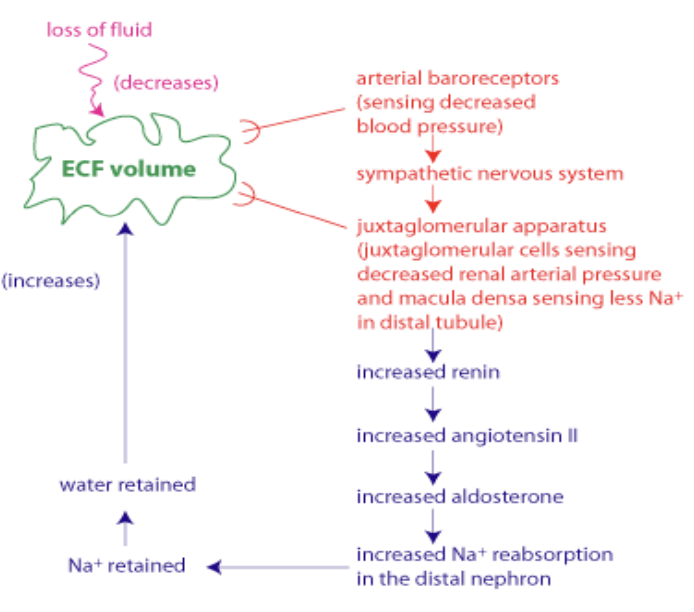Regulatory Role of Kidney
1/12
There's no tags or description
Looks like no tags are added yet.
Name | Mastery | Learn | Test | Matching | Spaced |
|---|
No study sessions yet.
13 Terms
Electrolyte Composition of Body Fluids
ECF
Major cation
Major anion
ICF
Chief cation
Chief anion
ECF:
Major cation: Na+
Major anion: Cl-
ICF:
Chief cation: K+
Chief anion: PO4-
How are the kidneys involved in the maintenance of homeostasis of ECF?
Regulates the composition and volume of ECF
Regulation of Water Intake
Thirst mechanism is triggered by
Thirst is gone by
Results in
Thirst mechanism is triggered by:
Increase in ECF osmolality
Decrease plasma volume
Thirst is gone by: Moistened of mucosa of mouth and distention of stomach and intestines
Results in: Inhibition of hypothalamic thirst center
Influence of ADH
What is proportional to ADH release
What occurs when ADH is low
Results in
What occurs when ADH is high
How is ADH secretion promoted or inhibited
What is proportional to ADH release: Amount of water reabsorbed in collecting ducts
What occurs when ADH is low: Most water in CD is NOT reabsorbed
Results in: Diluted urine
What occurs when ADH is high: Water in CD is reabsorbed
Results in: Concentrated urine
How is ADH secretion promoted or inhibited: By the hypothalamus in response to change in
Solute concentration of ECF
Changes in blood volume/pressure
Regulation of Plasma Volume of ECF
ECF volume decreases, what happens to reabsorption of Na and H2O?
ECF volume increases, what happens to reabsorption of Na and H2O?
What are the sensors
Secrete
Leads to
So when Na decreases, aldosterone
ECF volume decreases, what happens to reabsorption of Na and H2O: Reabsorption increases
ECF volume increases, what happens to reabsorption of Na and H2O: Reabsorption decreases
What are the sensors: Carotid baroreceptors, juxta cells, macula densa
Secrete: Renin
Leads to:
Increased aldosterone secretion —>
Increase Na+ reabsorption —>
Increase ECF volume
Na decreases: Aldosterone increases

Osmotic Regulation of ADH
ADH released from
ADH release regulated by
What cells monitor the osmolality of ECF
Increase in ECF osmolality causes ADH release to
Results in
What is the negative feedback to inhibit additional release of ADH
ADH released from: Posterior pituitary gland
ADH release regulated by: Changes in ECF osmolality
What cells monitor the osmolality of ECF: Osmoreceptors in the hypothalamus
Increase in ECF osmolality causes ADH release to: Increase
Results in: Excretion of a small volume of hypertonic urine
What is the negative feedback to inhibit additional release of ADH: Reduction in ECF osmolality by excretion of large volume of dilute urine
Regulation of Aldosterone Secretion
What are the factors that regulation aldosterone secretion
How
Blood Volume or Cardiac Output
How:
When blood volume of cardiac output decrease
Loss of Na+ and water is compensated by
Increase in aldosterone secretion by
Adrenal cortex to increase tubular Na+ absorption
Physical Stress
How:
Increase physical stress causes
Anterior pituitary gland to increase secretion of ACTH (adrenocorticotrophic hormone)
Which stimulates aldosterone secretion by adrenal cortex
Regulation of Water Loss #00a9ff
Where is ADH synthesised
Where is ADH stored and released from
What is the main function of ADH in kidneys
How does ADH increase water reabsorption
What cells detect changes in osmolality
When there’s less water
Osmolality is
Function of osmoreceptors
Results in ADH secretion to
When there’s excess water
Osmolality is
Function of osmoreceptors
Results in ADH secretion to
Where is ADH synthesised: Hypothalamus
Where is ADH stored and released from: Posterior pituitary gland
What is the main function of ADH in kidneys: Increase water reabsorption in distal tubules and collecting ducts
How does ADH increase water reabsorption: Increases permeability of tubule walls to water
What cells detect changes in osmolality: Osmoreceptors
When there’s less water:
Osmolality is: Increase
Function of osmoreceptors: Crenate and stimulate
Results in ADH secretion to: Increase
When there’s excess water:
Osmolality is: Decrease
Function of osmoreceptors: Expand
Results in ADH secretion to: Inhibited
Polyuria
What
How can animals become polyuric
What: The passage of larger volumes of urine than normal
How become polyuric: When animals cannot generate hypertonic urine when necessary
Polydipsia #ff7f00
What
What: Excessive thirst
How can animals develop polyuria and polydipsia?
Due to unregulated diabetes mellitus (increase blood glucose) because
Renal tubules cannot reabsorb the abnormally large amounts of glucose in glomerular filtrate
So the glucose that remains in renal tubules exert osmotic effect to retain water in tubules
Causing increased urine flow so animal must increase water intake to maintain water balance
How else can polyuria and polydipsia develop?
If ADH is not available or kidney doesn’t respond to ADH which causes
Water permeability of collecting ducts to decrease
So water can’t be reabsorbed from collecting ducts into blood
Aldosterone & Potassium Secretion
What effect does aldosterone have on K
What happens to K levels in urine when aldosterone increase
What happens to plasma K conc when aldosterone increase
How does K reach urine
What happens if there’s unregulated aldosterone secretion
What effect does aldosterone have on K: Promotes K secretion by principal cells in distal tubules and collecting ducts
What happens to K levels in urine when aldosterone increase: Urinary K loss increases
What happens to plasma K conc when aldosterone increase: It decreases to maintain K balance
How does K reach urine: Through tubular secretion in collecting duct
What happens if there’s unregulated aldosterone secretion: Causes severe plasma potassium loss